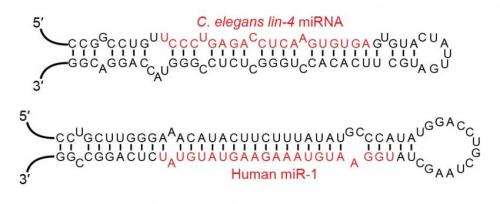Study identifies potential targets for treating venous ulcers

New insights into the role that small molecules called microRNAs play in human skin wound healing have been published today in eLife.
The study, which includes the first resource detailing the role of microRNAs in the wound-repair process, shows that aberrant levels of a trio of microRNAs may impair healing in venous ulcers. The findings suggest that drugs targeting these microRNAs could help facilitate healing in patients.
Venous ulcers commonly occur in the legs, caused by poor blood flow. These painful and slow-to-heal lesions can significantly impair an individual's mobility and quality of life. Previous research in animals has shown that persistent inflammation and insufficient cell growth and migration may contribute to the poor healing of these wounds, but few studies have looked at the role of gene regulation in these processes in humans.
"MicroRNAs regulate hundreds of genes and play a crucial role in skin wound repair," says co-first author Zhuang Liu, a postdoctoral researcher at the Center for Molecular Medicine, Karolinska Institutet, Stockholm, Sweden. "But a limited amount of information about how microRNAs regulate gene expression in human wounds has hampered the identification of microRNAs that could be useful therapeutic targets."
To fill this gap, the team collected 20 wound tissue samples from healthy volunteers with healing wounds on their legs and patients with venous ulcers. The samples were taken at three different time points to track the healing process. The team then used RNA sequencing to compare the expression of microRNAs and other molecules, called messenger RNAs, in healing and non-healing wounds at these time points.
They discovered that 22 microRNAs and 221 messenger RNAs were expressed at higher levels in venous ulcers than in healing wounds, while 10 microRNAs and 203 messenger RNAs were expressed at lower levels. They also found that 17 microRNAs with elevated or abnormally low levels in patients with venous ulcers target genes involved in the condition.
Next, the researchers conducted a series of experiments on human skin cells, called keratinocytes, collected from another set of healthy volunteers and patients with venous ulcers. These experiments confirmed the abnormal expression of several of these microRNAs and their gene targets in wound healing.
Finally, they demonstrated that the elevated expression of three microRNAs in particular—microRNA-34a, microRNA-424 and microRNA-516—increased the inflammatory response, as well as slowed the growth of new cells and the migration of cells needed to help close a wound.
"Our work opens the door to developing new treatments for venous ulcers that reduce the levels of this microRNA trio to help restore normal wound healing in patients," says co-first author Letian Zhang, a Ph.D. student at the Center for Molecular Medicine, Karolinska Institutet. "MicroRNA-targeting therapies could be more effective and have fewer side effects in patients than some existing therapies for venous ulcers."
Documenting the microRNAs at different time points in the healing process is particularly important, adds co-senior author Pehr Sommar, a senior physician at the Department of Plastic and Reconstructive Surgery, Karolinska University Hospital, Stockholm, Sweden. "Elevated microRNA expression might promote healing at one point in the process and hinder it at another, so timing will be essential for potential microRNA-targeting therapies," he says. "But we first need more studies looking at microRNAs in individual skin cells to validate our findings before we can test the effectiveness of this approach in patients."
As part of their study, the team created a compendium of their findings and made it available online to help other researchers who study the wound-healing process. "We hope this resource will help scientists learn more about how microRNAs regulate tissue repair, as well as accelerate studies of potential microRNA-targeting wound treatments," concludes co-senior author Ning Xu Landén, associate professor in experimental dermatology at the Department of Medicine Solna, Karolinska Institutet.
More information: Zhuang Liu et al, Integrative small and long RNA omics analysis of human healing and nonhealing wounds discovers cooperating microRNAs as therapeutic targets, eLife (2022). DOI: 10.7554/eLife.80322
Compendium: www.xulandenlab.com/humanwounds-mirna-mrna



















